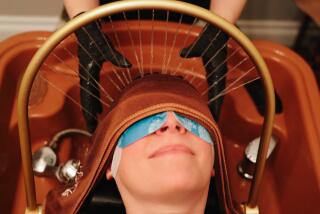Spa treatments go minimal
The latest fad in the frou-frou world of pampering isn’t a new thermal seaweed wrap, mud bath or cucumber-infused mineral water. It’s doing away with them.
For years, typical treatments at elite spa establishments could easily run $125 or more for a one-hour massage. The new normal: Less than $50, and sometimes as low as 20 bucks.
“It’s no longer an indulgence,” said Candy Boroditsky, 65, after receiving a $49, 50-minute Swedish massage at Massage Envy in Marina del Rey. “It used to be people who made a certain amount of money — the Beverly Hills housewives — were the ones who got the massages. This made it for the everyday woman.”
No-frills massage boutiques have surged in popularity in the Southland thanks to the recession. The change comes amid a growing awareness of health and wellness and the proliferation of daily-deals websites such as Groupon and LivingSocial that offer huge discounts.
That’s helped transform the once-exclusive world of spas and in particular has lowered the cost of massages. Gone are many of the extras such as bathrobes, slippers and saunas. In some cases, private massage rooms are sacrificed for thin curtains or communal rooms.
“Half the time you’re facedown staring at a carpet.... The other half of the time you’re face-up and your eyes are closed and you’re in a dimly lit room,” said Michael Marylander, founder of the Massage Place chain in Southern California, where a one-hour massage costs $47. “So I don’t see the value in having a nicer place.”
The businesses aren’t always fancy — many are in strip malls — but customers say they’re convenient and affordable.
Like many spa-goers, Tara Prieto couldn’t afford spending hundreds of dollars on extravagant spa getaways. So the USC graduate student traded down to cheaper places including Chinese foot-massage shops, where she pays $20 for a one-hour, full-body massage. The catch: Customers sit fully clothed in a large public room during the service.
“It’s definitely more practical,” Prieto, of West Los Angeles, said. “It’s not like, ‘OK, I’m going to go there and relax.’ ”
Owners of these inexpensive massage businesses stress that “cheap” doesn’t mean “sleazy.”
They say their massage therapists are all licensed and many employees split their time between budget boutiques and high-end spas. To get the point across, some — such as Top Thai in Thai Town, which charges $35 for a one-hour massage — post notices on their walls warning customers not to ask for sex.
“The overall perception of a massage establishment has changed,” Marylander said, adding that in the past, many people assumed a massage boutique was code for “prostitution place,” which made it difficult to get landlords on board.
These days, with commercial real estate widely available, signing a lease isn’t a problem. Spa owners say the challenge now is the plethora of new players and deals that have increased competition.
Last month, for instance, the Massage Company in Santa Monica — already a low-cost boutique — offered a deal on LivingSocial for a 90-minute massage starting at $35; more than 4,000 vouchers sold out in a few hours.
Spas are also increasingly turning to membership programs, which give regular clients reduced prices.
At Massage Envy, which has 663 locations nationwide, members generally pay a monthly fee of $59, which entitles them to a 50-minute massage every month and discounts on products and other services.
Membership last year increased 29% to more than 900,000 members, said David Humphrey, chief executive of Massage Envy, which opened six new Los Angeles-area locations.
To cut costs, the company has eliminated the bells and whistles such as steam rooms and “exotic tea blends,” he said. But there’s one area where customers won’t skimp: “They can live without the puffery and the gold leaf if the massage is of comparable quality,” he said. “They’re not willing to sacrifice that.”
Even high-end spas are taking note.
Burke Williams, the elite chain of day spas, offers monthly specials that it touts on Facebook and in 2009 launched its own membership program. For $79 a month, members receive a 50-minute massage or facial; for $109 a month, they can also use the spa facilities throughout the month.
The economy “does certainly require us to develop programs like our membership program, and that program will stay,” said Sandra Miller, Burke Williams’ director of marketing. “Had the recession not hit, I suppose we might not have thought of that in the same way.”
The International Spa Assn. said total spa industry revenue fell 4.3% to $12.3 billion in 2009 from the previous year, the most recent data available. That year 63% of spas introduced discounts and incentives to attract first-time clients and 18% introduced membership programs, the association said.
Adding to the competition are new businesses in Koreatown, Thai Town and the San Gabriel Valley that offer Eastern massage treatments at a fraction of the cost of luxury day spas on the Westside — although privacy is often sacrificed.
At massage boutiques in Thai Town, where one-hour massages cost about $40, customers usually lie on mats on the floor and turn their heads to one side instead of resting them in a face cradle. At Wilshire Spa in Koreatown, which expanded in 2009, nude customers receive their massages in the open.
Others say a massage isn’t a massage without the pomp.
Kiko Secor, 27, said she felt “not as relaxed” when she tried budget massages and preferred the leisurely, all-day affair at typical day spas such as Burke Williams.
“I feel they take care of all the details [like] refrigerated washcloths and scented oils on it,” the marketing manager from Laguna Beach said. “I keep going back even though I know it’s more expensive.”
Although the trend emerged during the economic downturn, many spa owners and experts think the discount massage mind-set is here to stay.
“Consumers just aren’t willing to go back in time, even though the economy has picked up,” said Lynne McNees, president of the International Spa Assn. “The mentality has changed. We’re not willing to pay full price for anything anymore.”






